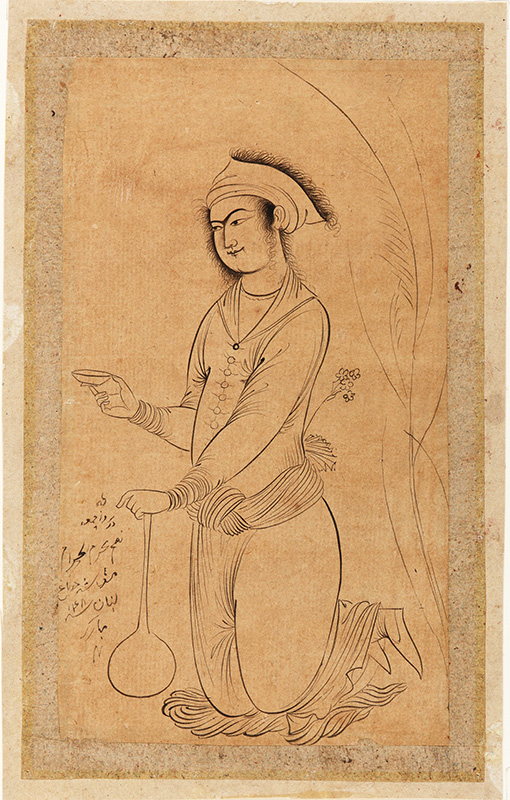Moʿin Moṣavver | Individual Drawings and Paintings
Drawing 1638.2
Cup-bearer, Kneeling, Offering a Cup
Location: Smithsonian Institution, Freer Gallery of Art, no. F1953.26; Purchased Charles Lang Freer Endowment.
Formerly in the Sarre Collection, Berlin.
Ink drawing on paper: (H x W) 16.4 x 9.4 cm.
Signature: Not signed but dated 1[0]48/1638..
Inscription
In the lower left: . . . dar ruz-e jomʿa nahhom-e moḥarram al-ḥarām mašq šod dar bāǧ-e liån [or niån?] sana 1[0]48 mobārak . . .
Translation: “Drawn in the garden of Liān (or Niān?) on Friday the ninth of the sacred month of Moḥarram in the year 1[0]48/ 23 May 1638, blessings . . . ”.
23 May was actually a Sunday, not a Friday.
The inscription is unsigned, but the handwriting may be that of Moʿin Moṣavver (cf. inscription 1672.1). The final word of the inscription is unintelligible, but the same word appears again at the end of an inscription on 1639.1, and possibly a third time on 1640.2.
Description:
The drawing is executed in pen and ink which results in linework much “harder” than in the previous drawing. The subject, a young male échanson, is shown in three-quarter view facing to our left. He kneels on the ground, his feet behind him, his left hand resting on the top of a long-necked bottle, his right arm extended with a small dish in hand. The subject wears a long gown that buttons down the front to the waist, with long sleeves and a collar that is open at the neck. A sash is knotted about his waist with a loose end protruding from behind. His habiliments are completed with pointed slippers and a loose fur trimmed beret-like cap that reaches his forehead. A narcissus protrudes from the sash in the back, and a few lines casually suggesting foliage appear on the far right. The hair and the fur of the cap are shaded black. The significance of the narcissus is not readily apparent.
Bibliography:
Sarre-Mittwoch, ZRA_1914, pl.14, p.28.
Kühnel, Survey_1939, p.1894 (not ill.).
Stchoukine, SA_1964, p.63 (not ill.).
Baḵtiyār, RA_1971, pl. p.13.
Commentary:
The drawing betrays a debt to Reżā ʿAbbāsi, perhaps it may even be a copy of the master’s work, but the style is already divorced from that of Reżā. The depiction of the facial features is comparable to other works that can be associated with Moʿin - cf. 1638.1 and 1639.1 in particular - which, like this drawing, lack indelible documentation, but in aggregate suggest the emerging, not yet fully formed style of Moʿin Moṣavver.
Photo courtesy of The Freer Gallery of Art, Smithsonian Institution, © The Freer Gallery of Art
Robert Eng
Last Updated: February 12, 2018 | Originally published: February 12, 2018
